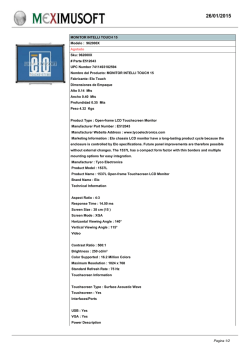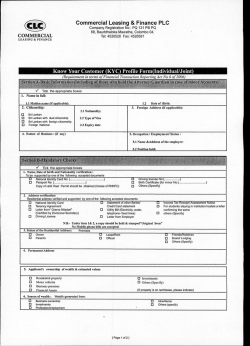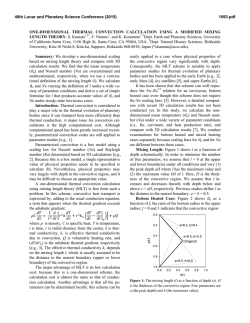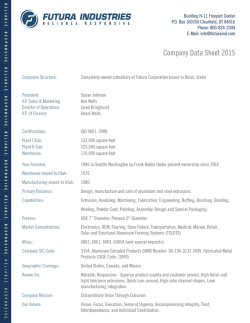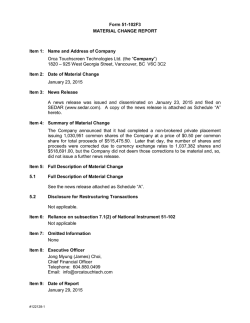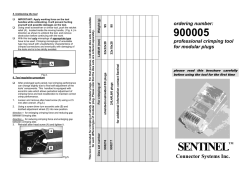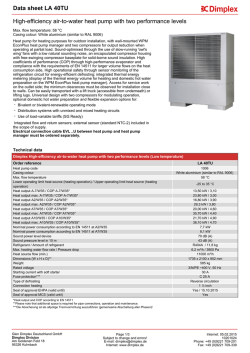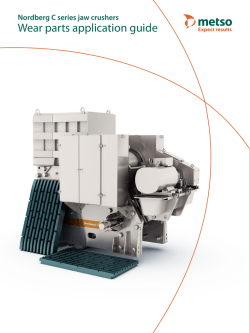
CTS-Superovens NEW - Castool Tooling Systems
SUPEROVENS The single cell die oven, which was such a huge advance over the chest oven, just isn’t good enough any more. Since its introduction thirty-odd years ago, the SCDO has remained relatively unchanged. There have naturally been incremental improvements, but these haven’t nearly kept pace with the demands of today’s marketplace. PURPOSE • Die to be equal to billet temperature for the first push, minimizing break through pressure enabling the use of high performance dies, reducing die breakage and eliminating start up billets • Minimize die bearing oxidation and nitride layer degradation responsible for surface defects on the profile, shorter die life, and reduced die knock-off FUNCTION To heat the die uniformly to within +/- 5ºC (10ºF) of billet temperature in the minimum amount of time without over heating and softening the die steel or damaging the nitride layer on the die bearing. Allper developed the ARP plunger over 20 years ago. A forged beryllium copper tip is securely fastened to a stainless steel holder with a quick release bayonet coupling. Water flow is from the center of the shot rod, through the stainless holder, and directly to the inside face of the plunger tip where a turbulent flow is generated to maximize the heat transfer. It then goes through four channels to the circular external coolant return passage. • Castool found that in their die ovens where radiant heat was used, the rate of heating the die does not depend primarily on its mass, but more so on the amount of surface area exposed to direct radiant energy. • The innovative technology of Castool’s new SUPEROVENS features four heating panels instead of two and also double the usual rate of converting electrical energy into heat for about half the usual time. • This results in an improvement of at least 30% less than the previous best time to temperature when heating dies. • The total amount of energy used, and therefore the actual total cost of heating the die is accordingly reduced. • If it previously required eight single cell ovens to service a press, the 30% increase in die throughput means that eight ovens can be reduced to six, with a corresponding reduction in necessary floor space. BENEFITS of the Castool Die Ovens • No billets wasted and scrap produced by ensuring a die is brought completely to optimum operation temperature • Avoids the use of higher temperature first billets • The die is individually heated completely and uniformly to operation temperature so rapidly, that oxidation of the bearing is minimal, and bearing surface integrity is maintained to ensure optimum extrusion surface finish • Extrusion weight consistency (lbs/ft or kg/m) is improved by quickly reaching steady state thermal conditions Master Controller Each individual Castool die oven just now has an opening mechanism and a controller. The controller contains several algorithms, so that if you input the size of the die and the target temperature, it will then select the most appropriate program to heat that particular die. It will use the necessary heat head and soak time to heat the die most efficiently, and with the accuracy required. Castool has developed these algorithms over a number of years. They incorporate the number of kilowatts that are actually being put into the die, the radiant heat, what the heat loss is, the thermal conductivity of the die steel, and also what the surface area is that we can actually hit directly with radiant energy. With that information we can accurately calculate the optimum heating cycle, and also the time to temperature. • Dies are positively protected from overheating • Colored lights indicating the heating status of the dies. When the heating cycle starts, a yellow indicator light comes on. The controller shows “Time to temperature,” and begins to count down • Single cell ovens save money With the Superoven, Castool again sets a new standard of excellence in the extrusion industry. Results may vary depending on individual press characteristics and setup. Triple Cell Oven The TRC50 was developed for heating dies up to 14” (355 mm) diameter, typically used on presses with 7” diameter billet or less. It can provide up to 20 preheated dies per shift to the press. The TRC50 is very reasonable priced, has a small foot print, and comes with an integrated HMI and PLC 7” color touch screen on a pedestal. It has the same 11-gauge 304 stainless steel liner, 11-gauge cold rolled steel shell, ceramic insulation, and heating system as Castool’s Superovens. Maximum surface temperature is 35ºC during operation, as per CSA safety standard SPE-1000-13. www.castool.com Follow our blog at www.castool.com/blog Control Options: AB Micrologix PLC with 6” Monochrome Touchscreen Siemens 1200 PLC with 6” Monochrome Touchscreen Mitsubishi Q-Series PLC with 6” Monochrome Touchscreen CASTOOL MAKES EXTRUSION BETTER January 2015
© Copyright 2025

